The best ways to harvest parsley for the winter in dry, frozen and canned form
Parsley gives food a unique taste and aroma; it is a useful addition to salads, appetizers, first and second courses. It is used not only fresh in summer and autumn, but also harvested for the winter: dried, canned, frozen.
Greenhouse greens purchased in winter are practically devoid of vitamins and microelements. And properly harvested garden parsley remains useful throughout the entire shelf life.
The content of the article
What parsley is suitable for storage for the winter: selection and preparation
For storage for the winter, parsley is cut before flowering... At this time, the leaves of the plant are soft, with a bright, rich aroma. All nutrients are stored in the leaves and stems of the plant.
Council. It is better to cut greens for storage in sunny weather, when the dew dries.
Parsley for storage for the winter should be freshly cut... If you do not have your own crop, it is better to buy greens from a trusted seller in the market than in a supermarket. Herbs bought in a store lose their aroma and taste from improper, long-term storage.
Council. Do not buy parsley for long-term storage in a package in which you cannot see and smell the bunch.
When buying greens for harvesting for the winter, pay attention to the following signs:
- fresh parsley - uniform dark green color, not windy;
- the leaves should not be torn off on the branches;
- if you wrinkle a leaf, you can feel the aroma of greenery;
- if you buy parsley with root, it should be white.

Before harvesting, the green part is separated from the roots, sorted out, dry and yellow leaves are removed... Then put in a colander and rinsed with cold running water. Shake off thoroughly and lay out on a towel until completely dry.
Parsley is harvested for the winter in various ways:
- drying;
- freezing;
- salting;
- canning.
Interesting on the site:
Features of growing parsley in a greenhouse
Dried parsley for the winter
Dried herb retains its beneficial properties and spicy aroma... It requires little space for storage, as it is significantly reduced in size and weight.
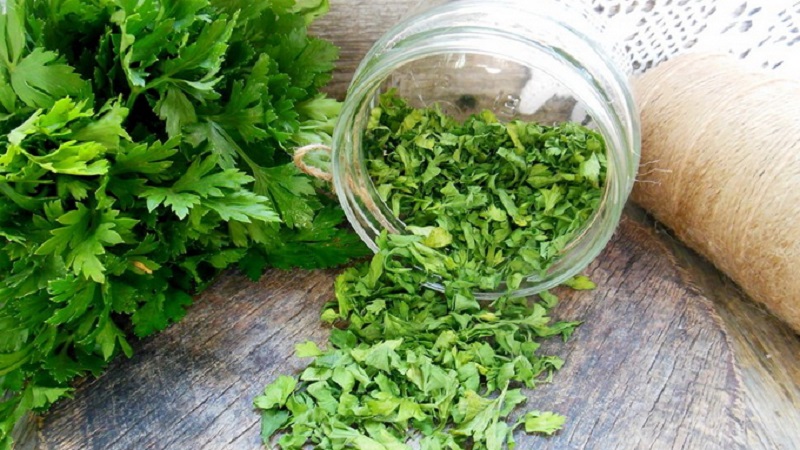
Drying in the oven
Optimum drying temperature 40-60 ° С... At higher temperatures, the product dries faster. But this spoils its appearance, many useful substances contained in the plant are lost.
The prepared twigs are laid out on a baking sheet. Dry in the oven with the door open for 5-6 hours.
If you cut the green mass and spread it on a baking sheet in a thin layer, it will be ready in 1.5-2 hours.
Drying in dryer
Greens are dried with whole branches or chopped... Lay out on a pallet. In the electric dryer set the mode "For herbs", the temperature is not more than 45 ° C. For even drying, it is recommended to replace the pallets every 1.5 hours. Drying time depends on the humidity of the air, the size of the cut and the amount of food.
Microwave drying
A flat dish is covered with a napkin on which parsley is spread... The microwave oven is turned on at full power for 2 minutes. Then the product is inspected: if it is not dry enough, the procedure is repeated. This happens until the product is completely ready.
Air drying
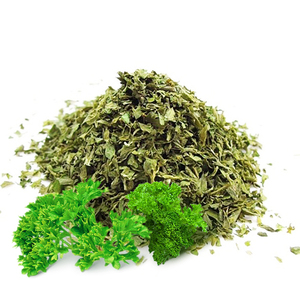 The longest, but no less effective way... Dried parsley with twigs or chopped. Greens are laid out on pallets no more than 1 cm thick and placed in a ventilated area. The pallets are covered with gauze. The herbs are periodically turned over, which will speed up the drying time and prevent the product from drying out.
The longest, but no less effective way... Dried parsley with twigs or chopped. Greens are laid out on pallets no more than 1 cm thick and placed in a ventilated area. The pallets are covered with gauze. The herbs are periodically turned over, which will speed up the drying time and prevent the product from drying out.
Bunches of greenery can be hung under a canopy with the green part down in a well-ventilated place. Avoid direct sunlight on the product so that it does not turn yellow.
Drying times vary from 5 to 20 days depending on weather conditions and cutting thickness.
Readiness check
The degree of readiness is determined by appearance. The finished product crumbles easily. Dried parsley slightly changes its taste and smell.
Reference. When properly dried, parsley has a green color, a spicy aroma, and a slightly bitter taste.
Storing dried parsley
Dried chopped parsley is laid out in clean, dry jars with lids and stored in a dark place.
If you dried parsley on twigs, the leaves are freed from the stems, crushed, put in glass jars and put in a dark place.
Shelf life of dry seasoning -1 year.
Frozen parsley for the winter
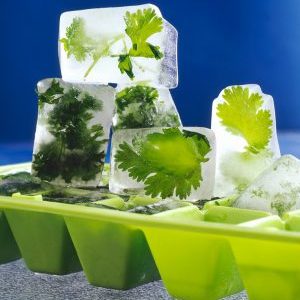 Frozen parsley retains its fragrant aroma and characteristic taste practically unchanged... Most of the vitamins are stored in it, and preparation for freezing will not take much time. Parsley is frozen in bunches, whole branches and in chopped form.
Frozen parsley retains its fragrant aroma and characteristic taste practically unchanged... Most of the vitamins are stored in it, and preparation for freezing will not take much time. Parsley is frozen in bunches, whole branches and in chopped form.
To freeze and store the product in the freezer, use ordinary plastic bags or special food containers for freezing, cling film.
For high-quality freezing, it is importantso that the selected container is tightly closed. When frozen in a bag, excess air is squeezed out of it.
Council. For freezing, choose a small container so that the food is less exposed to warm air when it is removed from the freezer. This affects the quality and shelf life of the product.
Store frozen parsley at -5 ... -20 ° С... Lower temperatures preserve vitamins and nutrients contained in greens better.
It is not recommended to re-freeze the thawed product., as this will affect its quality.
Shelf life of frozen product - 1 yearif it has not been re-frozen.
Council. Label containers to track expiration dates and identify the right food in the freezer.
Freezing in ice cube trays
 Parsley is sorted out and washed... Rough stems are cut off - they can be frozen separately and used in broth cooking to add a spicy aroma.
Parsley is sorted out and washed... Rough stems are cut off - they can be frozen separately and used in broth cooking to add a spicy aroma.
Parsley leaves are finely chopped with a knife. Place in ice cube trays and tamp thoroughly. Then pour in chilled boiled water. The molds are placed in the freezer for 4 hours. Then they are taken out, the ice cubes are quickly transferred to plastic bags, which are placed in the freezer for permanent storage.
Greens can also be chopped in a blender... At the same time, she will give juice, and you do not need to add water. The resulting mass is laid out in molds, tamped and frozen. Then the cubes are removed from the mold, laid out in bags and put into the freezer.
Frozen in oil
To prevent the greens from freezing and retain their color and smell, they are frozen in oil.... To do this, pre-prepared parsley leaves without stems are finely chopped with a knife or in a blender. Lay out in molds for 2/3 of the volume and fill in with vegetable oil. The molds are placed in the freezer.After freezing, the resulting cubes are laid out in bags or containers and placed in the freezer for long-term storage.
Read also:
Fresh frozen
When freezing fresh parsley, it is important to ensure that the greens were completely dry and did not stick together into one ice ball. Freeze greens whole and in bulk.
Freezing in bulk
The pre-prepared parsley is separated from the coarse stems and chopped. They are laid out in containers or packages (in bulk or twisted in a roll). Sign and put in the freezer for storage.
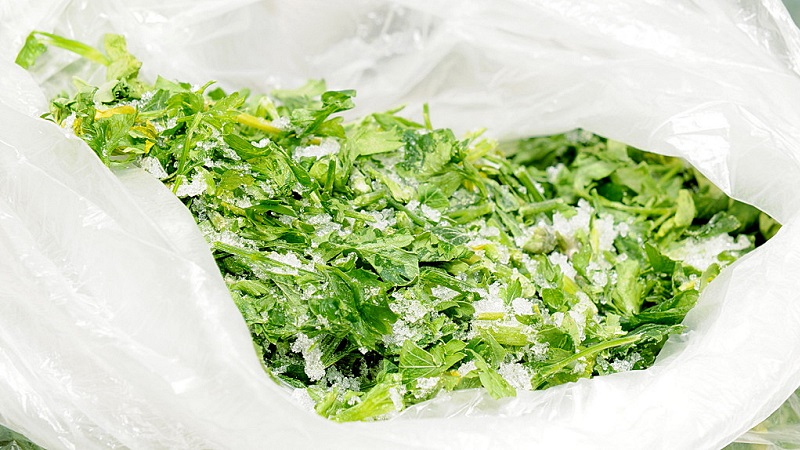
Freezing by twigs
If there is no time to mess around with shredding, parsley is frozen in bunches. To do this, the branches, ready for freezing, are divided into portioned bundles, each for one use. The bundle is wrapped in plastic wrap or bag to form a roll. Sign and put in the freezer for storage.
Parsley blanks for the winter
In addition to drying and freezing, there are other ways to prepare parsley for the winter. Consider the best recipes.
Salting with twigs in jars
Salting parsley without marinade is the easiest way to prepare.
Ingredients:
- parsley - 1 kg;
- salt - 200 g
The parsley is sorted out, the roots are cut off, washed and dried thoroughly. Place in a sterilized glass jar. Sprinkle the mass with salt. Close the lid tightly and store in the refrigerator. To prevent the mass from becoming moldy, sprinkle with salt on top.
Greens can be chopped and salted in the same way..
With dill
Parsley is also salted with the addition of other herbs, for example, dill.
Ingredients:
- parsley - 500 g;
- dill - 500 g;
- salt - 200 g
Parsley is sorted out, washed, dried, cut. Chopped greens are placed in a separate container, sprinkled with salt and mixed well. They are laid out in sterilized jars and tamped. To prevent mold from forming on top, sprinkle with additional salt. Jars are closed with lids and stored in the refrigerator.
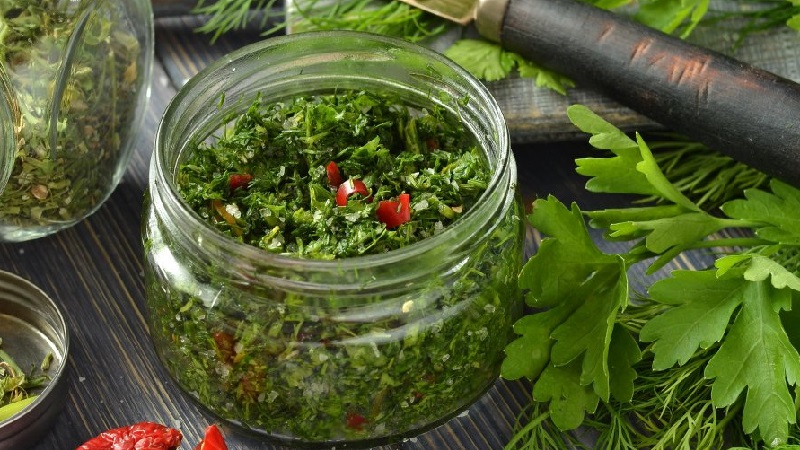
With celery
To obtain a vitamin mixture, several types of greens are mixed.
Ingredients:
- parsley - 250 g;
- dill - 250 g;
- celery - 250 g;
- salt - 250 g.
Parsley and dill are sorted out, washed and cut into a length of 1.5-2 cm. The celery is peeled, washed and cut into pieces 1.5-2 cm long. All components are mixed in a separate container, covered with salt and stirred. Then they are laid out in clean, dry jars and carefully tamped. Let it brew for 1-2 days. During this time, the mass decreases and lets out juice. After that, add a little more mass to the jar and close the lid. Store jars in a refrigerator or cool room.
In the marinade
Pickled parsley recipe that only takes 20-30 minutes to cook.
Ingredients:
- parsley - 500 g;
- vinegar - 150 ml;
- water - 0.8 l;
- sugar - 50 g;
- salt - 50 g;
- bay leaf - 2 pcs.;
- garlic - 4 teeth.
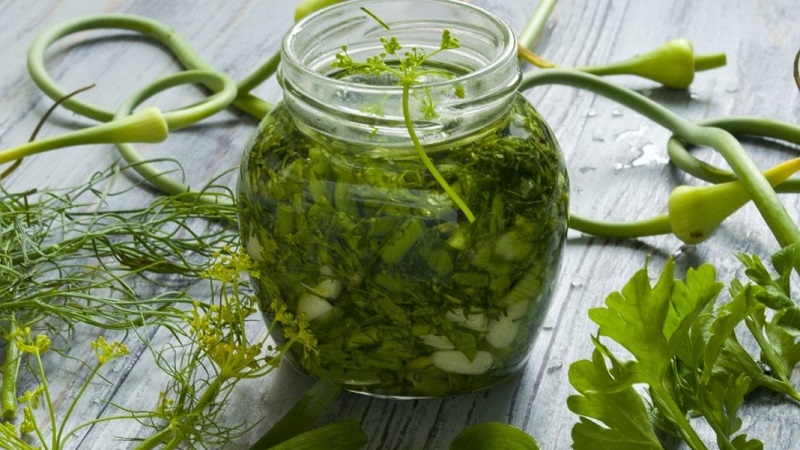
Parsley is sorted out, washed, roots are cut off, slightly dried and chopped. Garlic is peeled and chopped with a knife. Parsley and garlic are placed in sterilized jars. Prepare the marinade: boil water, add sugar, salt and bay leaf, cook for 10 minutes, add vinegar 2 minutes before the end of cooking. Pour parsley with a boiling solution.
A towel is placed at the bottom of a wide saucepan and a jar of herbs is placed on it. Water at a temperature of 80-90 ° C is poured into a saucepan and the workpiece is sterilized over low heat for 20 minutes. Then twist the lid, turn the jar over and cover it with a blanket. The cooled jars are stored in a cool, dark place.
In vegetable oil
Vegetable oil will protect the parsley from spoilage and extend the shelf life by 3-4 months.
Ingredients:
- parsley - 300 g;
- vegetable little - 200 ml.
Prepared greens are cut and put in a sterilized jar. The oil is heated in a water bath. Greens are poured to the top with hot oil, leaving no air bubbles.Close with a lid.
This method completely preserves the color, flavor and aroma of fresh parsley.
How to prepare parsley root for the winter
 Parsley roots are harvested in the fall when they gain mass and are maximally saturated with useful substances.
Parsley roots are harvested in the fall when they gain mass and are maximally saturated with useful substances.
Whole, not deformed specimens are taken for long-term storage. Dry by laying out in a well-ventilated area. Then they are stacked in layers in wooden boxes and sprinkled with sand. The boxes are installed in the cellar or basement. Optimum storage temperature 0-2 ° C, relative humidity 80%. Under these conditions, the roots will remain until spring.
If there is no cellar and basement, then parsley root, like its green part, is dried, frozen, salted or canned.
Before harvesting for the winter, the roots are thoroughly washed with running water, preferably with a coarse brush. Then a thin layer of skin is peeled off with a knife and dried. Cut into thin slices or strips.
Dry the root of the parsley under the same conditions as the green mass:
- in the oven - at a temperature of 40-60 ° C with an open door for 5-6 hours;
- in the dryer - at a temperature not exceeding 45 ° С with the set “For herbs” mode;
- in the microwave - at the maximum mode for 2 minutes (the drying mode is repeated until the product is completely dry);
- outdoors - on pallets, in a well-ventilated place for 5-20 days.
Dried roots are stored in paper or linen bags in a dark, well-ventilated place.
For freezing, cut slices of roots are laid out in bags, from which air is removed, and placed in the freezer.
Freeze roots in ice cube trays, like parsley... To do this, the roots are rubbed on a grater, laid out in molds, poured with water and frozen. Then the resulting cubes are laid out in bags and placed for long-term storage in a freezer.
For salting, the root is grated, placed in sterilized jars and sprinkled with salt in a ratio of 5: 1. Close with lids and store in the refrigerator.
To pickle the root, you need:
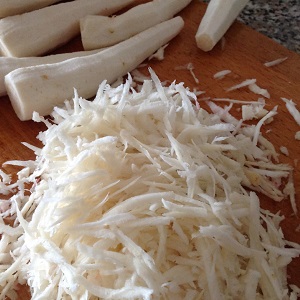 water - 4 glasses;
water - 4 glasses;- vinegar 9% - 1 glass;
- sugar - 0.5 cups;
- salt - 1 tsp;
- black peppercorns - 6 pcs.;
- garlic - 4 cloves.
The cooking algorithm is as follows:
- Parsley roots are cut into cubes, dipped in boiling water for 3 minutes, then discarded in a colander to glass the water.
- Prepare the marinade: add salt, sugar, pepper to boiling water and boil for 10 minutes, add vinegar 2 minutes before the end of cooking.
- The roots and peeled garlic are laid out in sterilized jars, filling the jar by ¾, pour boiling marinade.
- A cloth is placed at the bottom of the pan and a jar with a blank is placed on it.
- Water at a temperature of 80-90 ° C is poured into a saucepan and the workpiece is sterilized over low heat for 20 minutes. Then they twist the lid, turn the jar over and tear it up with a blanket.
- The cooled jars are stored in a cool, dark place.
Conclusion
During the period of marinades and pickles, do not forget about the preparation of greens. It is no less useful than vegetables, fruits and berries, and is used in many dishes. The preparation is simple and does not take much time.
There are several ways to stock parsley for future use: dry it, freeze it, pickle it, pickle it. Each option will add variety to your winter dining table.